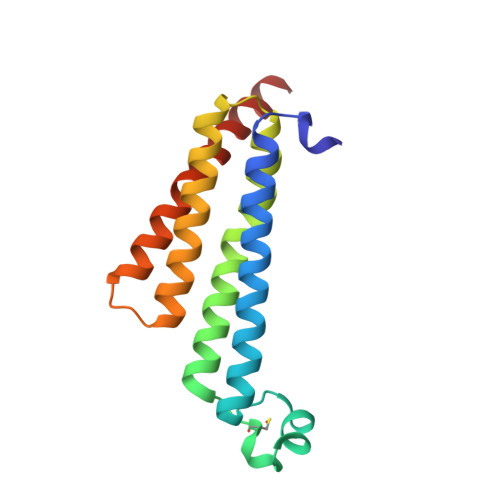Crystal Structures of mPGES-1 Inhibitor Complexes Form a Basis for the Rational Design of Potent Analgesic and Anti-Inflammatory Therapeutics.
Luz, J.G., Antonysamy, S., Kuklish, S.L., Condon, B., Lee, M.R., Allison, D., Yu, X.P., Chandrasekhar, S., Backer, R., Zhang, A., Russell, M., Chang, S.S., Harvey, A., Sloan, A.V., Fisher, M.J.(2015) J Med Chem 58: 4727-4737
- PubMed: 25961169
- DOI: https://doi.org/10.1021/acs.jmedchem.5b00330
- Primary Citation of Related Structures:
4YK5, 4YL0, 4YL1, 4YL3 - PubMed Abstract:
Microsomal prostaglandin E synthase 1 (mPGES-1) is an α-helical homotrimeric integral membrane inducible enzyme that catalyzes the formation of prostaglandin E2 (PGE2) from prostaglandin H2 (PGH2). Inhibition of mPGES-1 has been proposed as a therapeutic strategy for the treatment of pain, inflammation, and some cancers. Interest in mPGES-1 inhibition can, in part, be attributed to the potential circumvention of cardiovascular risks associated with anti-inflammatory cyclooxygenase 2 inhibitors (coxibs) by targeting the prostaglandin pathway downstream of PGH2 synthesis and avoiding suppression of antithrombotic prostacyclin production. We determined the crystal structure of mPGES-1 bound to four potent inhibitors in order to understand their structure-activity relationships and provide a framework for the rational design of improved molecules. In addition, we developed a light-scattering-based thermal stability assay to identify molecules for crystallographic studies.
Organizational Affiliation:
†Lilly Biotechnology Center San Diego, 10300 Campus Point Drive, Suite 200, San Diego, California 92121, United States.




















